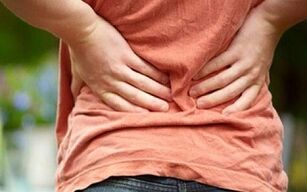
We believe you have read and heard that low back osteochondrosis usually affects bank employees and office workers, programmers and heavy manual labor representatives. This is true, but the whole fact is that today it is almost impossible to find at least one activity that has nothing to do with the risk of developing this disease.
why is that? Lower back osteochondrosis is a kind of "upright walking tax", which is a kind of tribute that each of us must pay tribute to nature. The reason for the degenerative changes of the cartilage tissue of the intervertebral disc is not so much the increase in the load of the nucleus pulposus, but the particularity of the blood supply of these structures.
By the age of about twenty, the arteries of the fibrocartilage tissue feeding IVD during adolescence have been eliminated. For all the remaining years, the nucleus pulposus and the annulus fibrosus only obtain nutrition through diffusion, which is obviously not enough! Trace elements, polysaccharides, amino acids and other structural components enter cartilage cells (cells that synthesize the intervertebral disc interstitium) in very limited quantities, which creates fertile ground for the development of the malnutrition process.
During our professional activities, we regularly sow seeds in this fertile soil. We sat in the wrong position, lifted a heavy object by mistake, moved a little bit, and spent a lot of time behind the steering wheel or behind the computer monitor. All other conditions are the same, this form of physical activity "will be out of touch with us", but in the case of the limited supply of cartilage structure in IVD, the degradation process will inevitably occur.
How does lower back osteochondrosis manifest?
The first manifestation of lumbar osteochondrosis is pain syndrome. Usually, the first time the "lucky man" had severe back pain and pierced his body with a dagger. Pain occurs after the torso is accidentally twisted, tilted, or hypothermia. There is no way to endure this kind of pain-it actually uses a person's legs to knit a person and tie him to bed.
What happens to the spine in the context of pain syndrome? To relieve pain, the nervous system sends stimulus signals to the deep back muscles. Increased muscle tone helps reduce the mobility of the diseased spine, which can reduce the severity of pain over a period of time. In the future, muscle fixation will no longer perform compensatory functions, and this imbalance of muscle tone will only exacerbate pain.
When examining such patients, the neuropathologist will detect signs of immobilization syndrome or the objective symptoms of the disease-changes in statics and kinetics. The static changes of lower lumbar osteochondrosis refer to the occurrence of flattening or aggravation of physiological curvature (scoliosis) and the appearance of pathological curvature-oriented pain (scoliosis). The dynamic symptoms of the disease seriously affect the mobility of the affected part (until it is completely fixed).
All these changes can be confirmed using spine imaging (spine X-ray) and more modern research methods (such as computed tomography and MRI). The image also shows that the height of the intervertebral disc in areas such as clinically important PDS, intervertebral disc herniation, and osteophyte is reduced.
Lower back osteochondrosis, treatment
The fixation and pain syndromes are combined with the morphological features on the diagnostic images to form a complete vertebral syndrome caused by osteochondrosis of the lower back. After completing the diagnosis phase, the next question we have to ask the doctor is how to treat this disease?
Of course, it is not the disease that needs to be cured, but the patient, but we will not get rid of philosophical discussions. We will solve more pressing problems-first, we must overcome the pain syndrome. For this, we need drugs that act systemically and locally, such as non-steroidal anti-inflammatory drugs, corticosteroids, muscle relaxants, and possibly even antidepressants. After alleviating the pain syndrome, he turned to conservative treatment.
If you are diagnosed with lumbar osteochondrosis, the treatment time will be very long, so you should be prepared morally and financially for this. In fact, legally speaking, it is impossible to completely overcome this disease, so you must see a doctor with a certain frequency until the end of the day.
The treatment algorithm is always individual, and it is developed by the attending doctor who understands the history of the disease. We only list the possible treatment directions. Reflexology has a positive effect, first of which is acupuncture. Some experts advocate the use of traction therapy, although other schools of chiropractic deny this technique. It is worth trying massage therapy. You must include back exercises (LFK) in your rehabilitation plan. You can also seek help from a qualified chiropractor.
Among the 100 conservative treatments, 90 cases are sufficient to control the disease, and the remaining 10 cases require surgical treatment. In the absence of absolute surgical indications (severe lumbar spondylolisthesis, spinal stenosis), minimally invasive surgery can be used for treatment. If the degree of morphological changes of the spine has reached a critical level, modern methods of disc reconstruction using implants can be used.























